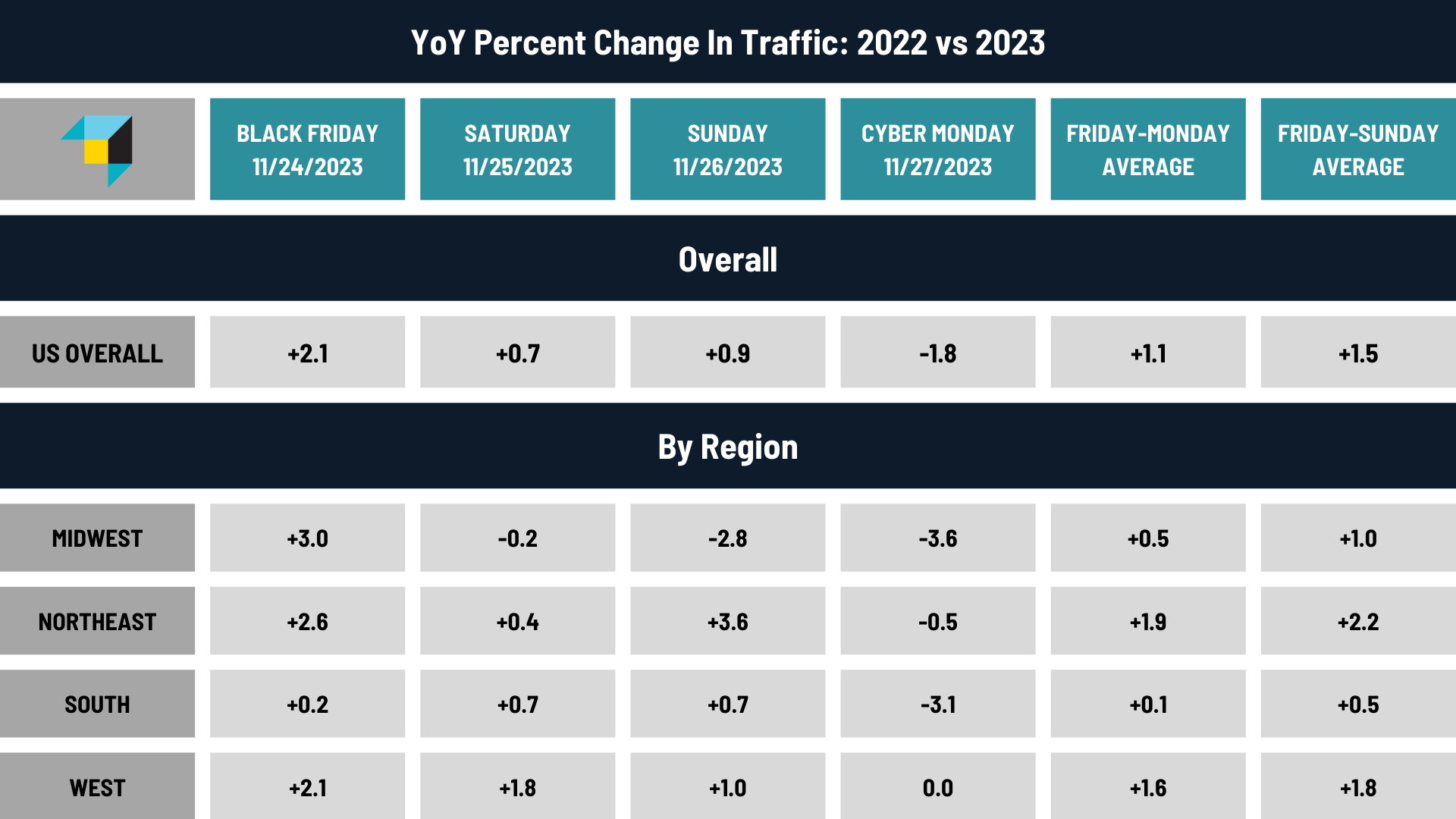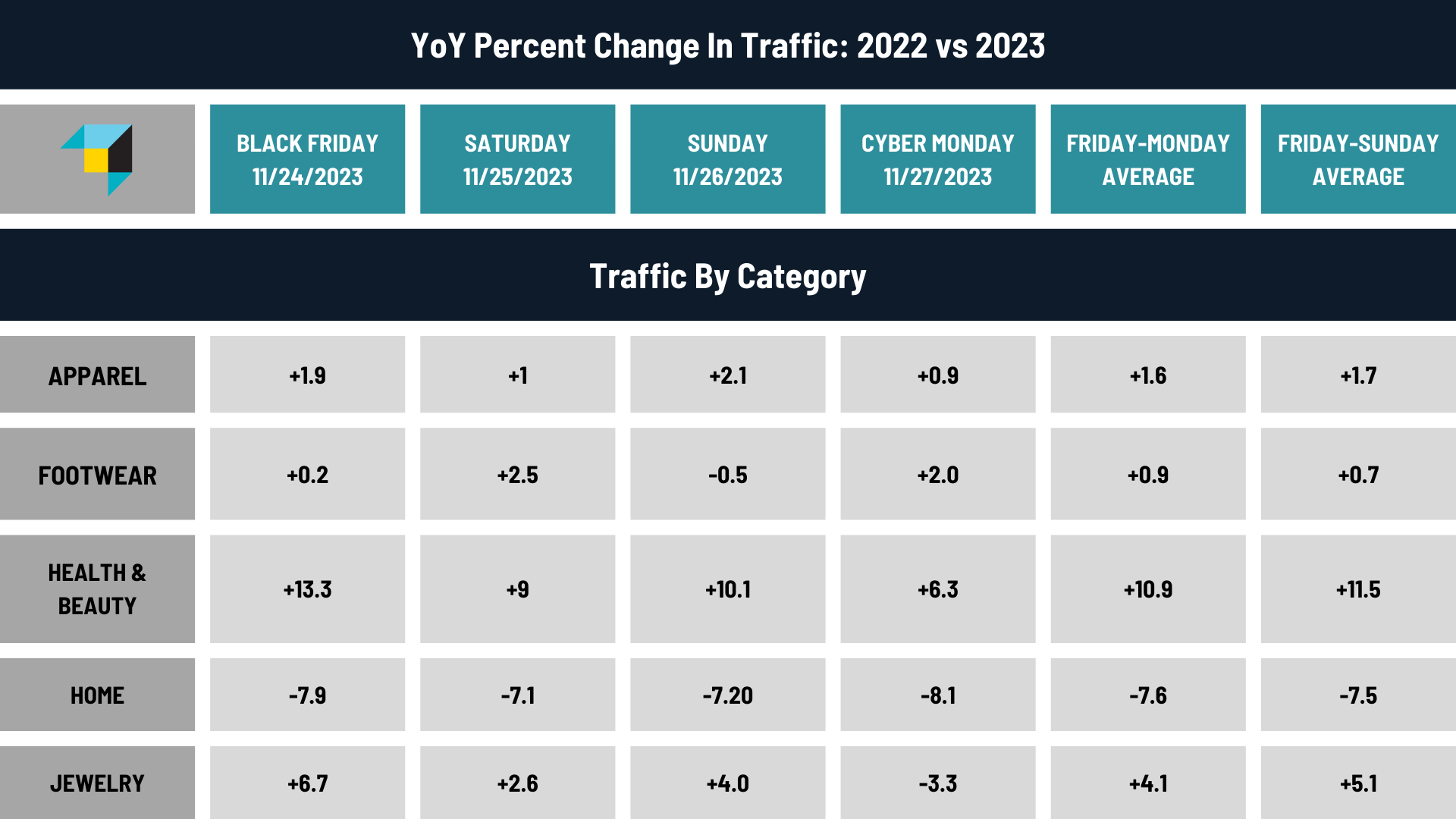One of the year’s key shopping occasions has come and gone. And although recent economic sentiment surveys have been negative, the resilience of American consumers has surprised forecasters all year. Despite the slow labor market, high mortgage rates, and student debt weighing heavily, shoppers showed up in droves to snap Black Friday deals. Perhaps Black Friday traffic was up YoY because of these macroeconomic uncertainties – shoppers are anxious to get the best value pre-festive season.
Fast Figures
- Foot traffic in the U.S. rose 1.5% YoY throughout Black Friday to Sunday (“Black Friday Weekend”) this year compared to 2022, surpassing recent initial expectations that traffic would be flat to negative 2% compared to last year.
- Health and beauty retailers experienced a remarkable 11.5% increase in Black Friday Weekend foot traffic, followed by jewelry with a 5.1% rise and apparel with a 1.7% increase over the same days.
- Conversely, there was a 7.5% decline in consumer interest in home goods during Black Friday Weekend.
The RetailNext sales and foot traffic figures surpassed projections, indicating consumers embraced in-store shopping despite prevalent challenges like escalating inflation and muted discretionary spending. This blog outlines key facts and figures about this year’s Black Friday store activity across the US.
Black Friday 2023 Traffic Snapshot
This year’s traffic data comes on the heels of a complex time for retailers as they aim to close out the year strong amidst a combination of inflation headwinds, shopping fatigue, consumer vulnerability due to rising living costs, and an overall rise in consumer debt. Nevertheless, turnout was strong, and stores maintained their footing.

As expected, Cyber Monday was felt in stores, with traffic dropping across all regions and national traffic down 1.8%. Encouragingly, the overall store traffic between Friday and Monday was up 1.1% regardless.

Health and beauty had a knockout year, with average YoY increases in the double digits. Jewelry also emerged strong with a 5.1% YoY increase in growth (Friday-Sunday average). Home, however, took a serious knock compared to 2022.
Expert Insights On Black Friday
Joe Shasteen, RetailNext’s Global Manager of Advanced Analytics, shared that “The U.S. has been trending at -2% to -5% over the past few weeks, so we expected a marginal lift for the week-over-week trends and a slight decline to flat YoY for the entire week. By comparison, physical store traffic rose an impressive 7% in 2022. Today’s results give us a glimpse into the consumer mind, which is increasingly cautious about discretionary spending amidst pressures like higher interest rates, student loan repayments, gas and grocery cost increases, increased credit card debt, and reduced savings rates.”
“The increase in U.S. store traffic over Black Friday Weekend is a positive development considering recent trends and is on the higher end of our expectations. This is a good sign for retail in the holiday period,” says Shasteen. “With discounting at an all-time high this year, it's likely the wider variety of discounted merchandise is boosting footfall as shoppers browse the best deals available. Other trends we expect to help drive traffic this year are the personalization in media and ads while the influence of social media (TikTok, Instagram) has continued to grow.”
As for a look into the future of retail traffic data trends, Joe notes: “From a retailer's perspective, discounting is giving their businesses the opportunity to reduce inventories and move products before the close of the year. It’s likely that retailers who adopted Buy Online, Pick Up In Store (BOPIS) during Cyber Week last year and experienced 38% higher growth according to Salesforce in 2022 are applying those learnings again this year. Demand for, and interest in, retail media networks is also a huge focus this year as retailers are increasingly looking to monetize their data by testing, innovating, and strengthening the link between their digital and physical assets.”